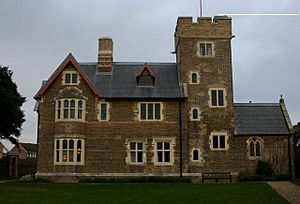The Grange, Ramsgate facts for kids
Quick facts for kids The Grange |
|
|---|---|

The south frontage
|
|
| Type | House |
| Location | Ramsgate, Kent, England |
| Built | 1843-1844 |
| Architect | Augustus Welby Northmore Pugin |
| Architectural style(s) | Gothic Revival |
| Governing body | Landmark Trust |
|
Listed Building – Grade I
|
|
| Official name: The Grange | |
| Designated | 13 August 1968 |
| Reference no. | 1203285 |
|
Listed Building – Grade II
|
|
| Official name: Carriage Gates and Gate Piers, Walls and West Wicket Gate at the Grange | |
| Designated | 23 June 1986 |
| Reference no. | 1336329 |
| Lua error in Module:Location_map at line 420: attempt to index field 'wikibase' (a nil value). | |
The Grange is a special house in Ramsgate, Kent, on the coast of southern England. A famous Victorian architect named Augustus Pugin designed it for himself. It was built between 1843 and 1844. Pugin wanted it to be his home and also show off his ideas about architecture. The house is built in the Gothic Revival style. The Landmark Trust saved it from being torn down in 1997. Today, The Grange is a Grade I listed building, which means it's very important and protected.
History of The Grange
Pugin bought the land for The Grange in Ramsgate in 1841. The house was built quite quickly, from 1843 to 1844. George Myers was the builder. Pugin's second wife passed away in 1844. It became a true family home after he married Jane Knill in 1848. The inside of the house was finished in 1850.
Pugin designed The Grange in a unique way. He planned the rooms first, then built the outside around them. This was different from the Georgian style popular before. That style usually planned the outside look first. Pugin's ideas influenced other English architects later on.
Sadly, Pugin died in the house in 1852. He was only 40 years old. He is buried nearby at St Augustine's Church. Pugin also designed this church. His oldest son, Edward Pugin, finished it.
Saving The Grange
Years later, The Grange was almost demolished. But the Landmark Trust stepped in and saved it in 1997. They worked to restore the house to how it looked in Pugin's time. They received help from groups like the Heritage Lottery Fund and English Heritage.
The Grange reopened in 2006. Now, people can stay there for short visits. Visitors can also see the house by appointment on Wednesdays. In 2010, The Grange won an award for its restoration from Country Life magazine. A TV show called Time Team also made a special episode about the restoration work and Pugin's life.
Architecture and Design
The Grange is a Grade I listed building. This means it's one of the most important historic buildings in England. It is protected by law. The house shows off the Gothic Revival style. This style brought back ideas from medieval Gothic buildings. Pugin used this style to create a home that was both beautiful and practical.

